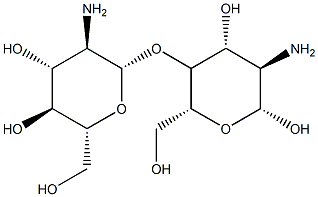148411-57-8
 148411-57-8 结构式
148411-57-8 结构式
基本信息
壳寡糖厂家
壳寡糖作用
壳寡糖报价
壳寡糖用途
食品级壳寡糖
壳寡糖生产厂家
壳聚糖寡糖乳酸
壳聚糖低聚乳酸酯
壳聚糖寡糖HCL
Chitosan Olibosaccharide
CHITOSAN OLIGOCOSACCHARIDE
average Mn 5,000
Chitosan oligosaccharide HCl
Alginate Oligosaccharide (AOS)
Chitosan oligosaccharide (COS)
CHITOSAN OLIGOSACCHARIDE LACTATE
Chitosan 2-hydroxypropanoate (ester)
Chitosan Oligosaccharide(Feed Grade)
物理化学性质
常见问题列表
食品级壳寡糖是由2-15个氨基葡萄糖单元构成的低聚糖,其医药、农业、轻工业等领域的广泛的功能已经得到学术界和市场的普遍认可。
壳聚糖低聚乳酸酯是 β-(1→4)-连接的 D-氨基葡萄糖的寡聚体,可激活 AMPK ,抑制NF-κB 和 MAPK在内的炎症信号通路。
AMPK
Chitosan oligosaccharide (COS) represents a class of natural polymers that holds therapeutic promise in several diseases due to not only its physiochemical properties including water-solubility and low viscosity but also its favorable pharmacological properties including good pharmacokinetics and safety profiles and diverse beneficial biological activities. Activation of AMPK and inhibition of inflammatory signaling pathways including NF-κB and MAPK pathways are recognized as major mechanisms responsible for several effects of Chitosan oligosaccharide (COS) including anti-inflammation, anti-cancer, and anti-diabetes. COS can interrupt cancer progression at multiple stages by modulating several signaling proteins/pathways including NF-κB, AMPK, mTOR, caspase-3, CD147, MMP-2, MMP-9, and VEGF. In vitro experiments have demonstrated that Chitosan oligosaccharide (COS) induced the death of several cancer cell types including ascites, bladder cancer, prostate cancer, lung cancer, liver cancer, leukemia, cervical cancer and colorectal cancer. The values of IC 50 of Chitosan oligosaccharide (COS) in inducing cytotoxicity are 25 μg/mL-50 μg/mL depending on types of cancer cells.
The oral administration of Chitosan oligosaccharide (16 mg/kg/day) suppresses the production of the proinflammatory cytokines involved in allergic reactions, i.e., IL-4, IL-13 and TNF-α, in the lung tissues and bronchoalveolar lavage fluid of the mice. Last, an anti-inflammatory effect of Chitosan oligosaccharide (COS) on lymphocyte activation has been documented in a rat model of autoimmune anterior uveitis induced by immunization with bovine melanin-associated antigen. Chitosan oligosaccharide (COS) inhibits UV-induced macroscopic appearance in mice skin. Compared with healthy dorsal skin with smoothness and some shallow wrinkles of hairless mice in normal control group, UV exposure for 10 weeks triggers skin erythema, dry, thickening, sagging and coarse wrinkles, and even leathery appearance and slight flesh-colored lesion in the model mice, the visual score of which is markedly higher than that of the normal control group (p<0.05), indicating that UV induces photoaging in skin surface.